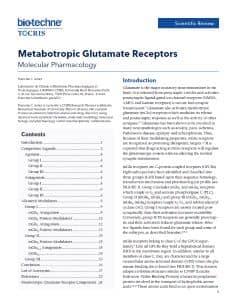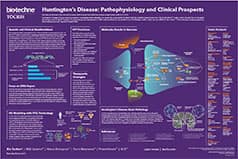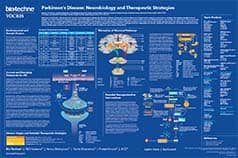Glutamate (Metabotropic) Group I Receptors
Metabotropic glutamate (mGlu) group I receptors are members of the metabotropic class of glutamate receptors, which also includes mGlu group II and mGlu group III receptors. mGlu group I receptors are divided into two subtypes, mGlu1 and mGlu5.
Glutamate (Metabotropic) Group I Receptor Agonists |
|
|---|---|
| Cat. No. | Product Name / Activity |
| 0187 | (±)-trans-ACPD |
| Group I and II mGlu agonist | |
| 1049 | CHPG |
| mGlu5 selective agonist | |
| 3695 | CHPG Sodium salt |
| Selective mGlu5 agonist; sodium salt of CHPG (Cat. No. 1049) | |
| 0342 | (RS)-3,5-DHPG |
| Selective group I mGlu agonist | |
| 0805 | (S)-3,5-DHPG |
| Selective group I mGlu agonist; active enantiomer of 3,5-DHPG (Cat. No. 0342) | |
| 0188 | L-Quisqualic acid |
| Group I mGlu agonist; also AMPA agonist | |
| 0162 | S-Sulfo-L-cysteine sodium salt |
| Group I mGlu agonist | |
Glutamate (Metabotropic) Group I Receptor Inverse Agonists |
|
| Cat. No. | Product Name / Activity |
| 2501 | Bay 36-7620 |
| mGlu1 inverse agonist | |
Glutamate (Metabotropic) Group I Receptor Antagonists |
|
| Cat. No. | Product Name / Activity |
| 0904 | AIDA |
| Potent and selective group I mGlu antagonist | |
| 5614 | AZD 2066 |
| mGlu5 antagonist; orally bioavailable and brain penetrant | |
| 5613 | AZD 9272 |
| Potent and selective mGlu5 antagonist; brain penetrant | |
| 0323 | (S)-4-Carboxyphenylglycine |
| Competitive group I mGlu antagonist; also weak group II agonist | |
| 1028 | CPCCOEt |
| Selective non-competitive mGlu1 antagonist | |
| 2333 | JNJ 16259685 |
| Highly potent, mGlu1-selective non-competitive antagonist | |
| 1237 | LY 367385 |
| Selective mGlu1a antagonist | |
| 2390 | LY 456236 hydrochloride |
| Selective mGlu1 antagonist | |
| 1212 | MPEP hydrochloride |
| Potent mGlu5 antagonist; also positive allosteric modulator of mGlu4 receptors | |
| 2921 | MTEP hydrochloride |
| Potent and selective mGlu5 antagonist | |
| 4134 | NPS 2390 |
| Group I mGlu antagonist | |
| 1027 | PHCCC |
| Potent group I mGlu antagonist | |
Glutamate (Metabotropic) Group I Receptor Modulators |
|
| Cat. No. | Product Name / Activity |
| 4416 | ADX 10059 hydrochloride |
| Negative allosteric modulator of mGlu5 receptors | |
| 3235 | CDPPB |
| Positive allosteric modulator of mGlu5 receptors | |
| 2386 | Fenobam |
| Potent and selective mGlu5 negative allosteric modulator (NAM) | |
| 6859 | FITM |
| Potent and selective negative allosteric modulator of mGlu1 receptors | |
| 5000 | FTIDC |
| Potent and selective negative allosteric modulator of mGlu1 receptors; also mGlu1 inverse agonist | |
| 5275 | LSN 2463359 |
| Potent and selective positive allosteric modulator of mGlu5 receptors | |
| 4347 | Ro 67-4853 |
| Positive allosteric modulator of group I mGlu receptors | |
| 4346 | Ro 67-7476 |
| Positive allosteric modulator of mGlu1 receptors | |
| 4323 | VU 0360172 hydrochloride |
| Positive allosteric modulator of mGlu5 receptors | |
| 5693 | VU 0409551 |
| Selective positive allosteric modulator of mGlu5 receptors; brain penetrant and orally bioavailable | |
| 5379 | VU 0469650 hydrochloride |
| Potent and selective negative allosteric modulator of mGlu1 receptors | |
Metabotropic glutamate (mGlu) group I receptors are members of the metabotropic class of glutamate receptors, which also includes mGlu group II and mGlu group III receptors. mGlu group I receptors are divided into two subtypes, mGlu1 and mGlu5. Group I mGluRs are coupled to Gq/11, which activates phospholipase C. They are also associated with Na+ and K+ channels. Their action is generally excitatory, increasing conductance, causing more glutamate to be released from the presynaptic cell. They can also increase inhibitory postsynaptic potentials (IPSPs), inhibit glutamate release and modulate voltage-dependent calcium channels. Group I mGluRs, unlike other groups, are activated by 3,5-dihydroxyphenylglycine (DHPG), allowing their function to be isolated. The human genes for mGluR1 and mGluR5 receptors have been localized to chromosomes 6 (6q24) and 11 (11q14.3) respectively.
External sources of pharmacological information for Glutamate (Metabotropic) Group I Receptors :
Literature for Glutamate (Metabotropic) Group I Receptors
Tocris offers the following scientific literature for Glutamate (Metabotropic) Group I Receptors to showcase our products. We invite you to request* your copy today!
*Please note that Tocris will only send literature to established scientific business / institute addresses.
Addiction Poster
The key feature of drug addiction is the inability to stop using a drug despite clear evidence of harm. This poster describes the brain circuits associated with addiction, and provides an overview of the main classes of addictive drugs and the neurotransmitter systems that they target.
Depression Poster
Major depressive disorder is characterized by depressed mood and a loss of interest and/or pleasure. Updated in 2015 this poster highlights presynaptic and postsynaptic targets for the potential treatment of major depressive disorder, as well as outlining the pharmacology of currently approved antidepressant drugs.
Huntington's Disease Poster
Huntington's disease (HD) is a severe monogenic neurodegenerative disorder, which is characterized by the prevalent loss of GABAergic medium spiny neurons (MSN) in the striatum. This poster summarizes the effects of mutant huntingtin aggregation implicated in the pathology of HD, as well as highlighting the use of iPSCs for HD modeling.
Parkinson's Disease Poster
Parkinson's disease (PD) causes chronic disability and is the second most common neurodegenerative condition. This poster outlines the neurobiology of the disease, as well as highlighting current therapeutic treatments for symptomatic PD, and emerging therapeutic strategies to delay PD onset and progression.




